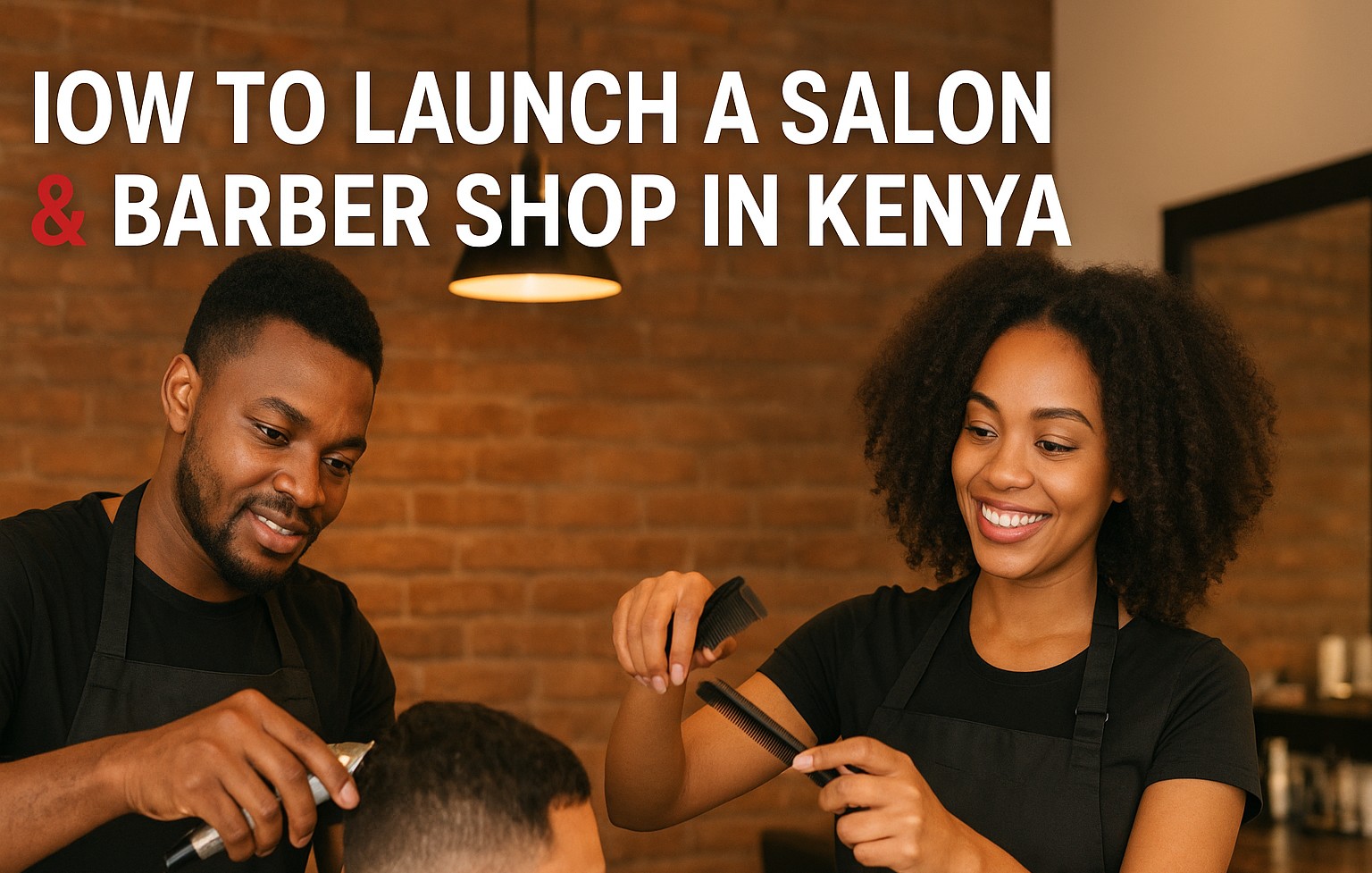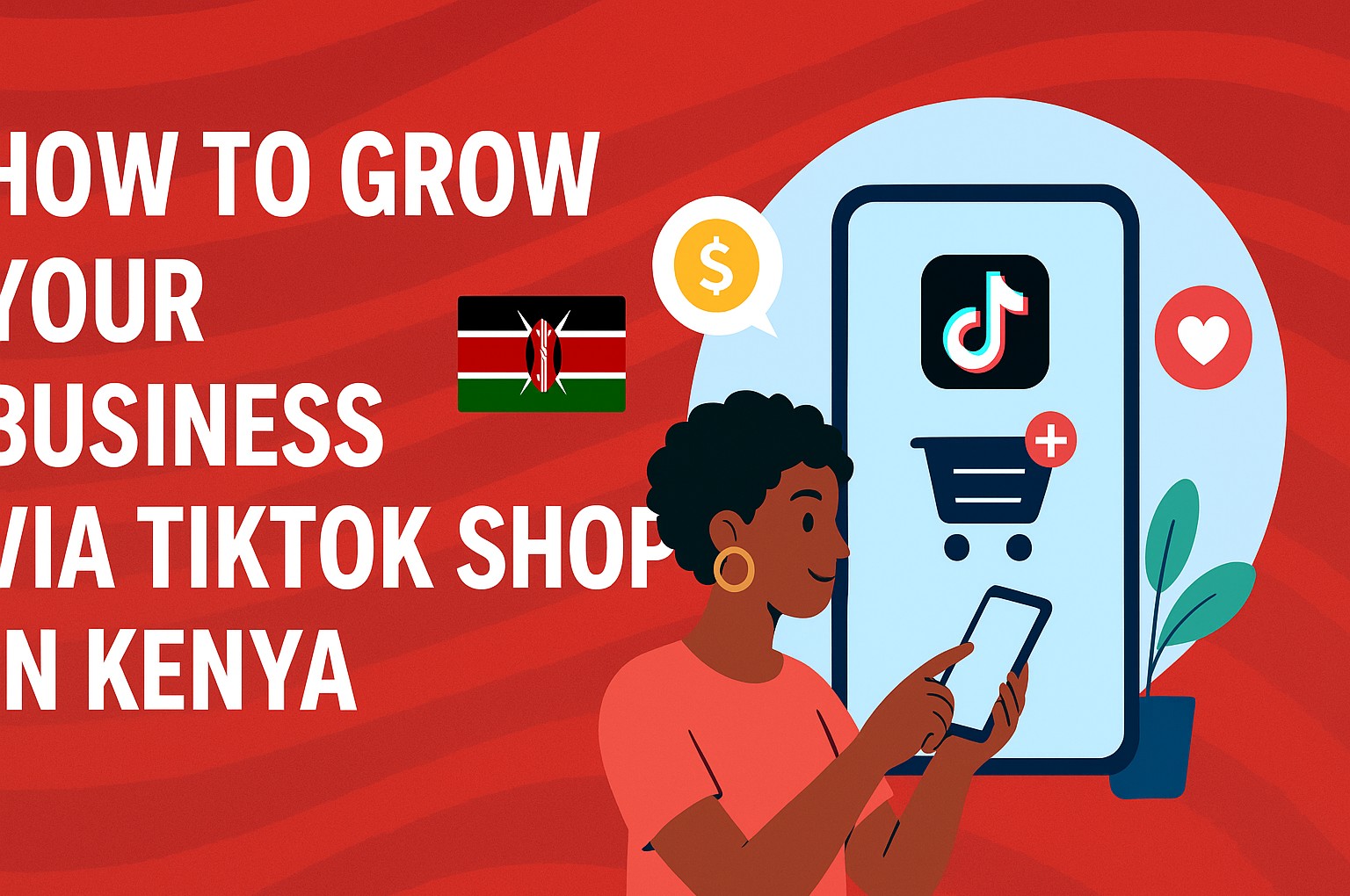

Titus Morebu
Author
How to Launch a Salon & Barber Shop in Kenya: Step-by-Step Guide 💇🏽♀️💈
Launch your dream salon or barber shop in Kenya — from planning and licensing to setup, marketing and growth. Get a clear, actionable roadmap to success.
Thinking of turning your passion for hair, grooming and beauty into a thriving business in Kenya? Here’s your complete, up-to-date guide to launching a salon + barber shop (kinyozi) that’s legal, profitable and built to last. We walk through every step — from idea to opening day — so you avoid costly mistakes and maximize your chance of ranking high (in both Google and your neighborhood).
Why a Salon + Barber Business Makes Sense in Kenya
- Consistent demand: People always need haircuts, grooming and beauty services, which makes this a relatively recession-resistant business.
- Rising middle class & trends: As more Kenyans care about personal appearance, demand for stylish salons, premium services and branded products is growing.
- Low barrier to entry (scaled): You can start small (single chair, one barber) and expand gradually.
- Retail + services synergy: You can sell hair care or beauty products to boost revenue.
1. Market Research & Positioning
Define your niche
Decide whether you’ll focus on:
- Men’s grooming / classic barbershop (kinyozi)
- Women’s salon (hair, nails, treatments)
- Full-service beauty boutique (hair, skin, nails, spa)
- Hybrid (mix barber + beauty)
Your niche affects location choice, pricing, equipment and staff.
Analyze your target area
- Foot traffic, visibility, parking, accessibility
- Competition: count existing salons / kinyozi nearby and their pricing
- Affordability: what your ideal customers can pay per haircut or service
- Complementary businesses: near malls, markets, schools, offices
Estimate demand & pricing
Survey the local community: how often do people cut hair, how much they’re paying, what services they use (e.g. hair coloring, braiding, fades). Use this data to set your prices realistically.
2. Business Planning & Financial Projections
Create a detailed business plan
Include sections on mission, services, pricing, operations, marketing, staffing, competitive analysis, SWOT, and financial forecasts (at least first 12 months).
Startup capital & cost estimates
The required capital depends on your scale and location. Here’s a rough guide in Kenyan shillings:
- Small / budget setup: Ksh 50,000 – 100,000
- Medium shop: Ksh 100,000 – 500,000
- Premium / upscale: Ksh 500,000 to 2 million+ depending on size and décor
Typical cost items include shop rent, renovations, furniture & chairs, sinks & plumbing, mirrors, lighting, clippers/hair tools, products, signage, licensing, marketing, utilities, staff wages, etc.
3. Legal Setup, Licenses & Compliance
Register your business
Register with the Business Registration Service (BRS) and reserve your business name in Kenya. This is now merged into one step online. Choose a business structure (sole proprietor, partnership, limited company). Provide ID, PIN, address, etc.
Tax registration (KRA PIN / VAT)
Once registered, register with the Kenya Revenue Authority for a PIN. If your projected turnover exceeds the VAT threshold, register for VAT.
County / municipal licenses & permits
You must apply for a **Unified Business Permit** (or Single Business Permit) at the county level. This covers trade license, signage, health & sanitation, and fire safety clearance. Fees vary depending on location and size. Also obtain a health certificate (for consumables / hygiene), and fire clearance where required.
Other compliance matters
- Music license (if you’ll play background music)
- Waste disposal compliance & environmental rules
- Occupational safety & health standards (safety for staff & clients)
- Insurance for equipment, liability and workers
4. Selecting & Fitting Out Your Location
Lease or buy?
Leasing is more common upfront—ensure your lease terms permit alterations, signage, and the business type. Have a valid lease agreement or ownership documents in hand when applying for permits.
Shop layout & design principles
- Flow: clear pathway for clients (waiting → service → wash → exit)
- Lighting: bright and flattering lighting is essential
- Mirrors & visual space: large mirrors, open design
- Décor & theme: consistent branding visuals, comfortable waiting area
- Ventilation & plumbing: ensure sinks, drainage, clean water supply
- Display space: shelves for products you will sell
Equipment & furnishings (baseline list)
- Styling chairs, barber chairs, mirrors, wash basins
- Hairdryers, clippers, shears, trimmers, comb sets
- Furniture: reception desk, waiting chairs, display shelves
- Lighting fixtures, signage & branding
- Sterilization & sanitation kit (autoclaves, UV, disinfectant)
- Cash register / POS system, WiFi, POS terminal / mobile payment setup
- Storage cabinets, uniforms, towels, aprons
5. Hiring & Training Staff
Roles you may need
- Barbers / stylists / hairdressers
- Assistants / apprentices
- Receptionist / front desk
- Cleaning / sanitary staff
Recruitment & selection
Prioritize skill, professionalism, customer attitude. Offer trial days or task-based tests (e.g. haircut a mannequin). Get referrals from other salons.
Training & standards
Train staff in customer service, hygiene practices, upselling (retail products), consistency in service. Create a manual or SOP (Standard Operating Procedures).
6. Service Menu, Pricing & Upsells
Design a core service menu
Begin with essential services tailored to your niche. Example for a hybrid shop:
- Men’s haircuts, fades, beard trims
- Women’s styling, braiding, blowouts
- Wash & blow dry, coloring, treatments
- Nails, waxing, facials (if you extend into beauty)
Upsell & cross-sell options
Introduce product retail (shampoos, serums), add-ons like scalp treatments, conditioning masks, hair extensions. Offer “combo” packages.
Pricing strategies
Ensure your pricing covers costs + profit margin. Watch competitor pricing. Offer entry / premium tiers. Consider loyalty discounts, package deals, referral bonuses.
7. Launch Marketing & Customer Acquisition
Branding & online presence
- Create a logo, signage, color scheme
- Build a simple website / landing page listing your services, location, contact
- Set up social media pages (Instagram, Facebook, TikTok). Post before/after images, reels, client testimonials.
Local SEO & directory listings
Register your business on Google Business Profile (Maps). Use keywords like “salon in [your town]” or “barber shop near me.” Get reviews to boost local ranking.
Promotions, launch offers & partnerships
- Grand opening discounts, freebies (free trim, free treatment)
- Partner with local influencers or micro-influencers
- Loyalty cards, referral bonuses
- Flyers in nearby offices, estates, malls; collaborate with gyms or fashion shops
Retention & customer experience
Offer appointment reminders, follow-ups, feedback forms. Ensure consistency, cleanliness, good customer service.
8. Operations & Management Best Practices
Inventory & supplier management
Keep track of usage vs sales, reorder in time, negotiate bulk discounts. Use a spreadsheet or simple software.
Financial controls & bookkeeping
Separate business account, track revenues and expenses, maintain receipts, file taxes timely.
Performance metrics to watch
- Average revenue per service / per client
- Client retention rate, new vs returning clients
- Cost of supplies / consumables as a percentage of revenue
- Staff productivity, utilization rate (hours used vs idle time)
9. Common Challenges & How to Overcome Them
- Competition & pricing pressure: Differentiate by service quality, branding, atmosphere.
- Cash flow shortages: Keep a buffer, control costs, don’t over-invest early.
- Staff turnover: Incentivize, train, build culture and loyalty.
- Regulatory hiccups / inspections: Stay compliant, renew permits, maintain cleanliness and safety.
- Changing trends: Keep up with new styles, tools, training—invest in continuous staff development.
10. Scale & Growth Opportunities
- Open additional branches, kiosks or mobile salons
- Franchise your model once proven
- Develop your own brand of hair / beauty products for retail
- Offer training / workshops / masterclasses
- Expand into spa, skincare, aesthetics, nail studios
Final Steps & Launch Checklist ✅
- Finalize business name, registration & tax PIN
- Obtain all county permits, health & fire clearances
- Secure location, sign lease, renovate / furnish shop
- Install equipment, POS, inventory & product stock
- Hire and train staff, establish service standards
- Finalize your service menu and pricing
- Build online presence & social media profiles
- Execute a launch marketing campaign
- Open doors, deliver excellence, solicit feedback
Starting a salon + barber shop in Kenya is entirely possible with careful planning, smart investment and a passion for service. If you follow the steps above, you’ll not only launch successfully, but put yourself in a position to grow and dominate in your local market. Go get that first client — and make them want to come back! 💪
Looking for more resources or downloadable checklists? Check out reputable sites like Google Business or your county government website for permit requirements. Also explore training from beauty schools or licensed cosmetology boards to stay sharp.
Gallery

Related Articles
3 articles
How to Become a Supplier to Supermarkets in Kenya – A Step-by-Step Guide 🌟
Learn how to register, pitch, and win supply contracts with Kenyan supermarkets. Step-by-step process, tips, and legal requirements — your roadmap to success.

Best Money-Saving Strategies for Kenyan Small Business Owners
Practical and actionable tips for small business owners in Kenya to cut costs, boost profits, and build resilience in 2025.

How to Grow Your Business via TikTok Shop in Kenya 🚀
Unlock TikTok Shop Kenya strategies to boost sales, visibility and customer trust with proven tactics for 2025 success.